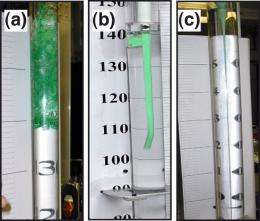Muddled mix the corniest way to plug leaky oil well

Call it better drilling through chemistry. The uncontrollable flood of oil into the Gulf of Mexico during last year's Deepwater Horizon disaster clearly illustrated that knowing how to stop the flow of oil when something goes wrong is an important part of the oil extraction business.
New research shows that one of the leading methods for "killing" an undersea petroleum leak can be greatly improved not by altering heavy machinery, but by the use of a simple chemical ingredient: cornstarch.
Chefs use cornstarch to thicken sauces. Jonathan Katz, a scientist at Washington University in St. Louis, said that cornstarch can also help to thicken the material shoved down errant pipelines to stop leaks.
In the "top kill" approach, mud -- a suspension of minerals and other chemicals in water or oil -- is injected into the leaking well, the goal being to plug up the well and keep further oil from entering it and flowing to the surface.
In the Gulf disaster last summer, this method failed largely because the outgoing stream of oil broke up the incoming stream of mud into small blobs that were swept out with the escaping oil, defeating the purpose of using the mud to form a solid plug.
Mud and oil are two forms of fluids. Whenever two fluids flow past one another, instabilities can start up. Wind blowing on the ocean -- another example of two fluids flowing past one another -- sets up waves on the surface of the water. Gravity, pulling downwards, helps to control the waves.
However, this process doesn't work in a vertical well where the oil stream buffets and breaks the mud into blobs, which are ineffective at stopping the oil.

In small-scale experiments in a lab, Katz added cornstarch to a surrogate mud. This provided just the right amount of binding needed for the job. The resulting mud still flows but holds together to provide the necessary seal for the well.
The secret is to be viscous or elastic when the oil flow is rapid.
Katz was part of a team of scientists who were consulted by Energy Secretary Steven Chu during the oil leak crisis. At that time, Katz predicted that the efforts then underway by BP and other recovery companies to plug the leak would fail.
Later Katz did his cornstarch experiments in response. Katz believes that the addition of cornstarch or an equivalent material can be scaled up to the level needed to kill a major oil leak.
Timothy J. Crone, a professor at Columbia University's Lamont Doherty Earth Observatory in Palisades, N.Y., agrees that cornstarch mixed with water forms a thick material that can stiffen while being deformed.
He believes that the use of that kind of material to prevent unwanted mixing of the ingoing and outgoing fluids in the well during a top-kill attempt "is indeed plausible and quite interesting."
"My question would be, during a top kill operation, whether the oil flow must be stopped in one slug as the mud and oil is pushed downward, or can a top kill work by filling the well with a viscoelastic mud from the bottom up?" Crone asked.
Even if mixing occurs at the bottom of the well, Crone suspected that sufficient mud might eventually stop the leak.
Katz, who will be publishing his results in the journal Physical Review Letters, has not yet heard from any oil company interested in his results.
Provided by Inside Science News Service




















